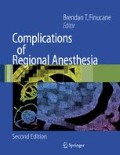Abstract
Modern anesthesia is a highly predictable undertaking with a very low failure rate. The ability to produce successful anesthesia is a less important characteristic of excellent anesthetic practice than the ability to recognize and treat adverse perioperative events. Recognition of myocardial ischemia or prompt treatment of catastrophic bleeding are examples of the situations requiring careful diagnosis and calm, decisive action. This same approach should prevail when the adverse event is a neurologic complication of regional anesthesia, only there is an added difficulty. At few other times in the practice of anesthesia will a practitioner be so directly confronted with responsibility for an adverse outcome as with a complication from neural blockade, because in a sense the “smoking gun” is clearly in our hands. Additional opprobrium may stem from the common misconceptions that complication rates should be zero in the practice of anesthesiology, and that the complication would not have occurred if only a general anesthetic had been performed.
Access this chapter
Tax calculation will be finalised at checkout
Purchases are for personal use only
Preview
Unable to display preview. Download preview PDF.
References
Yeun EC, Layzer RB, Weitz SR, Olney RK. Neurologic complications of lumbar epidural anesthesia and analgesia. Neurology 1995;45:1795–1801.
Moore DC, Hain RF, Ward A, Bridenbaugh LD. Importance of the perineural spaces in nerve blocking. JAMA 1954;156:1050–1053.
Kimura J. Electrodiagnosis in Diseases of Nerve and Muscle. 2nd ed. New York: Oxford University Press; 1989.
Osborn AG. Diagnostic Neuroradiology. St. Louis: Mosby; 1994.
Eddy DM, Clanton CH. The art of diagnosis: solving the clinicopathological exercise. N Engl J Med 1982;306:1263–1268.
Black WC, Welch HG. Advances in diagnostic imaging and overestimation of disease prevalence and the benefits of therapy. N Engl J Med 1993;328:1237–1243.
Author information
Authors and Affiliations
Editor information
Editors and Affiliations
Rights and permissions
Copyright information
© 2007 Springer Science+Business Media, LLC
About this chapter
Cite this chapter
Hogan, Q.H., Hendrix, L., Jaradeh, S. (2007). Evaluation of Neurologic Injury Following Regional Anesthesia. In: Finucane, B.T. (eds) Complications of Regional Anesthesia. Springer, New York, NY. https://doi.org/10.1007/978-0-387-68904-3_21
Download citation
DOI: https://doi.org/10.1007/978-0-387-68904-3_21
Publisher Name: Springer, New York, NY
Print ISBN: 978-0-387-37559-5
Online ISBN: 978-0-387-68904-3
eBook Packages: MedicineMedicine (R0)

